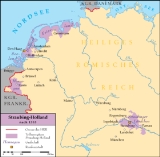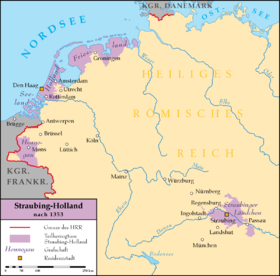
Bavaria-Straubing
Encyclopedia

Wittelsbach
The Wittelsbach family is a European royal family and a German dynasty from Bavaria.Members of the family served as Dukes, Electors and Kings of Bavaria , Counts Palatine of the Rhine , Margraves of Brandenburg , Counts of Holland, Hainaut and Zeeland , Elector-Archbishops of Cologne , Dukes of...
house of Bavaria that were governed by independent dukes of Bavaria-Straubing between 1353 and 1432; a map (illustration) of these marches
Marches
A march or mark refers to a border region similar to a frontier, such as the Welsh Marches, the borderland between England and Wales. During the Frankish Carolingian Dynasty, the word spread throughout Europe....
and outliers of the Holy Roman Empire
Holy Roman Empire
The Holy Roman Empire was a realm that existed from 962 to 1806 in Central Europe.It was ruled by the Holy Roman Emperor. Its character changed during the Middle Ages and the Early Modern period, when the power of the emperor gradually weakened in favour of the princes...
, vividly demonstrates the fractionalisation of lands where primogeniture
Primogeniture
Primogeniture is the right, by law or custom, of the firstborn to inherit the entire estate, to the exclusion of younger siblings . Historically, the term implied male primogeniture, to the exclusion of females...
did not obtain. In 1349, after Emperor Louis IV
Louis IV, Holy Roman Emperor
Louis IV , called the Bavarian, of the house of Wittelsbach, was the King of Germany from 1314, the King of Italy from 1327 and the Holy Roman Emperor from 1328....
's death, his sons divided Bavaria once again: Lower Bavaria
Lower Bavaria
Lower Bavaria is one of the seven administrative regions of Bavaria, Germany, located in the east of the state.- Geography :Lower Bavaria is subdivided into two regions - Landshut and Donau-Wald. Recent election results mark it as the most conservative part of Germany, generally giving huge...
passed to Stephan II (died 1375), William ( died 1389) and Albert (died 1404). In 1353, Lower Bavaria was further partitioned into Bavaria-Landshut
Bavaria-Landshut
-History:The creation of the duchy was the result of the death of Emperor Louis IV the Bavarian. In the Treaty of Landsberg 1349, which divided up Louis's empire, his sons Stephen, William, and Albert were to receive jointly Lower Bavaria and the Netherlands. Four years later the inheritance was...
and Bavaria-Straubing: William and Albert received a part of the Lower Bavarian inheritance, with a capital in Straubing
Straubing
Straubing is an independent city in Lower Bavaria, southern Germany. It is seat of the district of Straubing-Bogen. Annually in August the Gäubodenvolksfest, the second largest fair in Bavaria, is held....
and rights to Hainaut and Holland. Thus the dukes of Bavaria-Straubing were also counts of Hainaut
County of Hainaut
The County of Hainaut was a historical region in the Low Countries with its capital at Mons . In English sources it is often given the archaic spelling Hainault....
, counts of Holland
County of Holland
The County of Holland was a county in the Holy Roman Empire and from 1482 part of the Habsburg Netherlands in what is now the Netherlands. It covered an area roughly corresponding to the current Dutch provinces of North-Holland and South-Holland, as well as the islands of Terschelling, Vlieland,...
, and of Zeeland
Zeeland
Zeeland , also called Zealand in English, is the westernmost province of the Netherlands. The province, located in the south-west of the country, consists of a number of islands and a strip bordering Belgium. Its capital is Middelburg. With a population of about 380,000, its area is about...
.
In 1425, with the death of Duke John III, the Straubing dukes became extinct in the male line, and his possessions were partitioned by the Dukes of Bavaria-Munich
History of Bavaria
The history of Bavaria stretches from its earliest settlement and its formation as a stem duchy in the 6th century through its inclusion in the Holy Roman Empires to its status as an independent kingdom and, finally, as a large and significant Bundesland of the modern Federal Republic of...
, Bavaria-Landshut
Bavaria-Landshut
-History:The creation of the duchy was the result of the death of Emperor Louis IV the Bavarian. In the Treaty of Landsberg 1349, which divided up Louis's empire, his sons Stephen, William, and Albert were to receive jointly Lower Bavaria and the Netherlands. Four years later the inheritance was...
and Bavaria-Ingolstadt
Bavaria-Ingolstadt
Bavaria-Ingolstadt was a duchy which was part of the Holy Roman Empire from 1392 to 1447.-History:After the death of Stephen II in 1375, his sons Stephen III, Frederick, and John II jointly ruled Bavaria-Landshut. After seventeen years, the brothers decided to formally divide their inheritance...
only in 1429 under arbitration of the emperor. His niece Jacqueline became Countess of Hainaut in her own right.
Dukes of Bavaria-Straubing
- Jointly held by William I and Albert I 1347-1388
- Albert I "of Holland" 1388-1404
- Albert IIAlbert II, Duke of Bavaria-StraubingDuke Albert II or Albrecht was a feudal co-regent of his father Albert I, Duke of Bavaria in the counties of Holland, Hainaut, and Zeeland in the Low Countries. Additionally he administrated from 1389 until his death in 1397 the Bavarian province of Straubing in the name of his father, it being...
1389-1397 jointly held with Albert I - William IIWilliam II, Duke of Bavaria-StraubingDuke William II of Bavaria-Straubing KG was also count William VI of Holland, count William IV of Hainaut and count William V of Zeeland. He ruled from 1404 until 1417, when he died of a dog bite. William was a son of Albert I and Margaret of Brieg.-Biography:William, allied with the Hooks, was...
1404-1417 - John IIIJohn III, Duke of Bavaria-StraubingJohn III the Pitiless, Duke of Bavaria-Straubing , of the House of Wittelsbach, was first bishop of Liège 1389–1418 and then duke of Bavaria-Straubing and count of Holland and Hainaut 1418–1425...
1418-1425 disputed with - Jacqueline, Countess of HainautJacqueline, Countess of HainautJacqueline of Wittelsbach was Duchess of Bavaria-Straubing, Countess of Hainaut and Holland from 1417 to 1432...
1417-1432
After the succession struggle between Jacqueline and her uncle John, Bavaria-Straubing was divided between Bavaria-Ingolstadt
Bavaria-Ingolstadt
Bavaria-Ingolstadt was a duchy which was part of the Holy Roman Empire from 1392 to 1447.-History:After the death of Stephen II in 1375, his sons Stephen III, Frederick, and John II jointly ruled Bavaria-Landshut. After seventeen years, the brothers decided to formally divide their inheritance...
, Bavaria-Landshut
Bavaria-Landshut
-History:The creation of the duchy was the result of the death of Emperor Louis IV the Bavarian. In the Treaty of Landsberg 1349, which divided up Louis's empire, his sons Stephen, William, and Albert were to receive jointly Lower Bavaria and the Netherlands. Four years later the inheritance was...
, and Bavaria-Munich
Bavaria-Munich
-History:After the death of Stephen II in 1375, his sons Stephen III, Frederick, and John II jointly ruled Bavaria-Landshut. After seventeen years, the brothers decided to formally divide their inheritance. John received Bavaria-Munich, Stephen received Bavaria-Ingolstadt, while Frederick kept...
.

